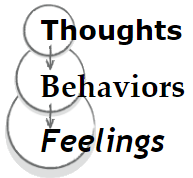
Dr. John V. Farrar
the snowman therapist
Tap To Call: (248) 210-3556
TBF Theory
The Snowman Story
The metaphor of the snowman is derived from a basic illustration shared with clients which
THOUGHTS are represented by the “T” in the snowman.
Moving from the “T” to the “B” illustrates that our thoughts generate our
BEHAVIORS as shown by the “B” in the snowman.
Ultimately, moving from the “B” to the “F” illustrates that our Behaviors (actions) produce
FEELINGS in us: the “F” in the bottom ball of the snowman.
I suggest to my clients that this is literally what our life is all about; our THOUGHTS (beliefs) lead us to BEHAVIORS (actions) in a given way. Based upon the results of those behaviors, we experience certain FEELINGS (emotions).
Clients never come for counseling because of their thoughts. No one ever enters my office, proclaiming “I’m just not thinking straight.” They come because of what they are doing (Behaviors) or because of how they are feeling (F). They seek counseling because of a threatened divorce, or because of a drunk driving citation, or because of some stress or anxiety-related physical symptom (behaviors). Others seek help with sadness, anger, or frustration (feelings).
While I attempt to encourage my clients with a hope that counseling can ultimately help them change their dysfunctional behaviors, eventually leading to greater happiness or contentment, the counseling process cannot begin at the “B” or “F” level. It must begin with our thoughts, ideas, and beliefs.
For example, why does any working person arise on a cold winter morning, dress, climb into the car and drive to work? Most of us would prefer to roll over and go back to sleep. Arising, dressing, and driving are all behaviors. Obviously, we do them because of some thought or belief we hold: such as, “If I don’t show up, I won’t get paid,” or perhaps we consider, “If I don’t get to work, I won’t be able to help my clients.” The specific idea or thought is the “parent” of the resulting action or behavior. In like fashion, every behavior produces some positive or negative emotional outcome.
Some of our thoughts serve us well. For example, the workers’ notion that they need to get out of bed and go to work ultimately generates a paycheck and, hopefully, some sense of purpose and accomplishment. But some thoughts do the opposite. For example, the individual who proceeds from the THOUGHT, “I need a drink,” indulges in a level of alcohol consumption (BEHAVIOR) which may lead to embarrassment or guilt (FEELING) due to an arrest or rebuke by a spouse or parent.
The counseling process, as practiced by cognitively-oriented counselors like myself, focuses on the “T’s” that trigger the “B’s” and eventually the “F’s” that follow. It truly is aimed at exploring the question: “What am I thinking?”

THE BOOK IS HERE!!
Thoughts. Behaviors. Feelings. These are the three pillars of the Farrars' approach to counseling. As a cognitive counselor, Dr. John believes our behaviors and feelings stem from our thoughts.
Dr. John draws upon years of experience and his work with over 300 women to identify six reasons why women choose dysfunctional and under-achieving partners.
Dr. John is an enthusiastic and entertaining presenter, able to convey his cognitively-oriented messages to audiences with a clear and entertaining style.
Call him today to schedule a workshop or seminar for you or your organization.
